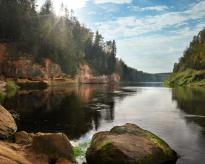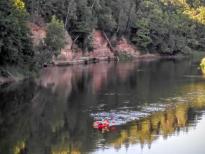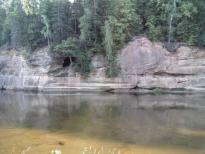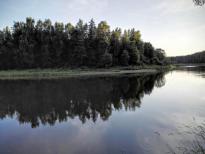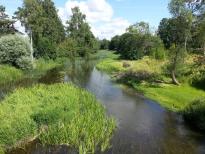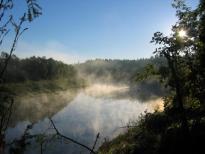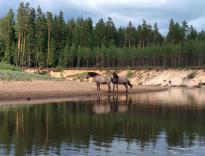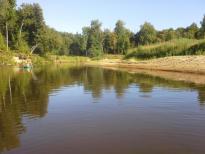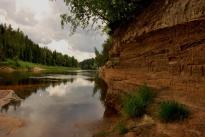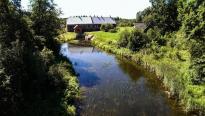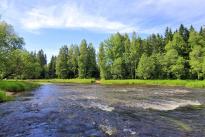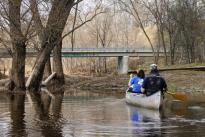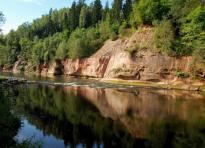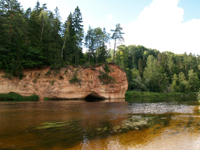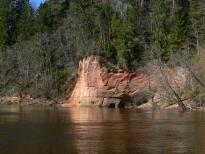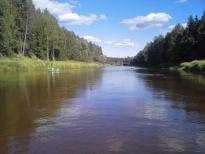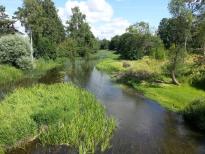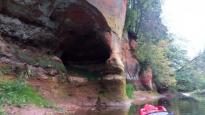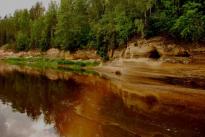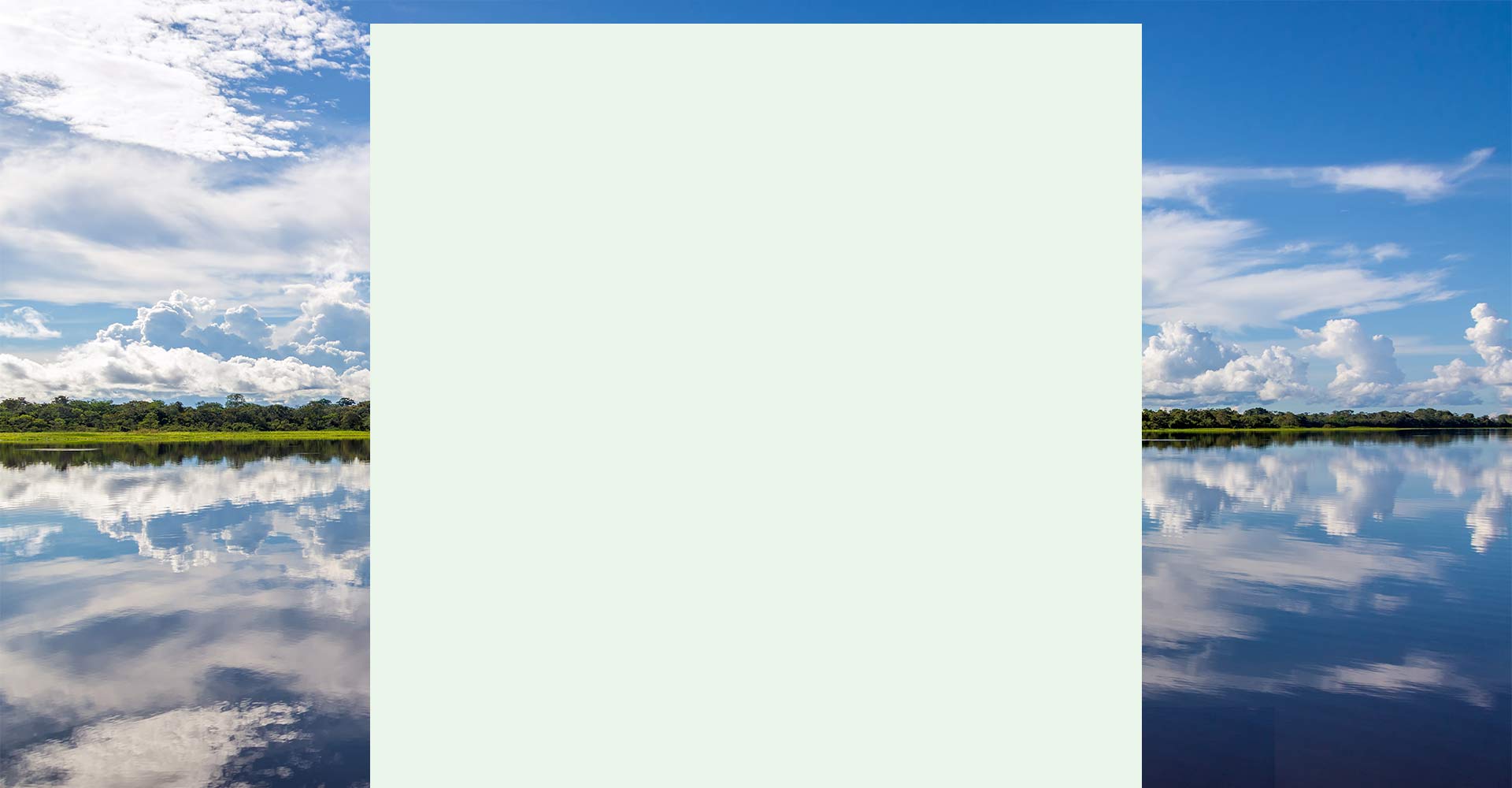
Gauja river route download for mobile devices (android/iphone)
The Gauja is the most popular paddling river in Latvia, what takes a capricious circle through Vidzeme, collecting 440 winding kilometres in total, while the distance in the air line between the outlet and estuary shows only 90 km.
In terms of water tourism the Gauja conditionally can be divided into 3 sections: section of HPPs cascade, in Popular section and in Upper course section.
Section of HPPs cascade is popular among paddlers - “collectors of different landscapes”, as well as here are cosy one and two-day routs with local rental boat points. In further 115 km there is a series of small lakes, overfalls and flooded dams in the Gauja.
Behind Lejasciems the Popular section of the Gauja is starting. Up to Aņņi (Valka - Gaujiena) bridge the Gauja is wide river with a good stream what flows mostly through bushy meadows. Behind Aņņi bridge the river begins to throw sharp bends and here starts 60 km long section up to Strenči what is famous due its sandbanks in internal sides of the bends and steep banks of loose sand, washed out by the river in the outer sides of bends. From Strenči to Valmiera the Gauja flows through populated and wooded area, while from Valmiera begins the most favorite section of the Gauja, which is 82.8 km long and continues up to Sigulda. Here are concentrated all of the most favourite sightseeing objects and cliffs..
Behind Sigulda the tourist flow sharply decreases and there is a feeling that the Gauja here is starting to breathe again. Behind Murjāņi the river flow becomes slower, the fast bends are ending, and the Gauja is full of large islands. At the Gauja estuary in the sea on the right bank there is a good access road and a place where to end the longest paddling route in Latvia.
One of the classic paddling routes along the Gauja River. Behind the railway bridge begins exciting river section - Strenči rapids, which continues until Krāčupe estuary. Further the river banks become higher and more picturesque. Behind the Mellupe estuary on the right bank is Sīmanēni Holy Oak, where it is possible to get the strength for further paddling. Closer to Valmiera the river has more sandbanks. The end of the route the in Daliņi is recommended for paddlers who are afraid to go through Kazu rapids in Valmiera, but if you have the skills for getting through rapids and you want to enjoy sharper feelings – surely go futher up to the boat station in Valmiera.
Behind Lejasciems the Gauja is no longer obstructed with HPPs and here can be enjoyed the natural flow of the river with a good stream. Paddlers will be spirited by Sikšņi un Vidaga rapids. Up to Vireši on the banks of the river can be seen dolomite outcrops.
The route begins upstream above Aņņi (P 23) bridge on the left bank of the river. Behind the bridge it is possible to see as oxbows are formed – the Gauja is straightened the riverbed. The river slowly flows through the floodplain meadows and further it winds through the woods, where one bank is washed out higher, the second one is flat with a wide sandbank. Forests are rich in berries and mushrooms. The route ends downstream behind Spicrāmis (P24) bridge on the right bank.
A few hours leisure trip from the comfortably accessible Jāņrāmis settlement up to Cēsis bridge. In the middle of the route are glorious Ēgrļi (Ērģeļu) rocks, where you can easily get out. At the cliffs are installed stairs that lead to get on a viewing platform and to watch the picturesque landscape.
This is the most popular and the most beautiful one day paddling route. Natural attractiveness of Gauja ancient valley is enjoyable both from the paddling boat and by getting out on the shore and looking at Līgavu cave, Kvēpene castle mound and secular oak. Riverbanks are decorated by Briedīši, Vecupe, Edernieku, Leimaņu, Spriņģu rocks and other glamorous outcrops. Majestic Ķūķu cliffs and rapids in several grades will spirit the paddlers. The destination of the route is Līgatne ferry crossing – the only ferry of this type in the Baltic States, which is still running.
One of the most popular two-day leisure routes that runs in the entire length through the Gauja National Park. Riverbanks are decorated with a glamorous rock outcrops and rocks. Briedīši, Vecupe, Edernieku, Leimaņu, Spriņģu, Katrīnas, Gūdu, Launaga rocks and other glamorous outcrops and caves. Majestic Ķūķu cliffs and rapids in several grades will spirit the paddlers. The destination of the route is Līgatne ferry crossing – the only ferry of this type in the Baltic States, which is still running. After Līgatne there begins calmer section. Closer to Sigulda it becomes really calm and almost at every turn will be able to see Turaida castle. We recommend to enjoy natural and cultural objects by getting out of the paddling boats and walking, it is worth to see Kvēpene oak and Līgatne nature trails, as well as to step on the Gleznotāju hill (Painters’ hill) in Sigulda.
The two-day leisure paddling route with enjoyment of attractiveness of the Gauja National Park landscape under accompaniment of calm flow of the river. On the banks of the river - Liepa rock, Sietiniezis rock, Ērgļi cliffs, and a little bit farther from the bank - Grīviņi rock and Līči – Laņģi cliffs.
Several days route through the Gauja National Park, Gauja ancient valley, which includes the most beautiful rocks, rocky outcrops, caves. It is possible to stop and step on Sietiņiezis rock, Ērgļi cliffs or another place with nice views, to walk along Cīrulīši or Līgatne nature trail, and finally to enjoy the natural splendour of the surroundings of Sigulda. For nature lovers it is better to choose the route in spring or autumn when there are less paddlers on the river.
One of the classic paddling routes along the Gauja River. Behind the railway bridge begins exciting river section - Strenči rapids, which continues until Krāčupe estuary. Further the river banks become higher and more picturesque. Behind the Mellupe estuary on the right bank is Sīmanēni Holy Oak, where it is possible to get the strength for further paddling. Closer to Valmiera the river has more sandbanks. The end of the route the in Daliņi is recommended for paddlers who are afraid to go through Kazu rapids in Valmiera, but if you have the skills for getting through rapids and you want to enjoy sharper feelings – surely go futher up to the boat station in Valmiera.
Interesants upes sākumposma maršruts, kur Gauja ir niedrēma aizaugušu posmu, ezeriņu, straujteču un aizsprostu uzpludinājumu virkne. Maršrutu labāk izvēleties pavasarī, kad augstāks ūdens līmenis.Pie Lodes ir svarīgi iekāpt Gaujā pie pareizā tilta – īstais ir pie Stupēnu ezera sākuma.Straujajos posmos jārēķinās ar nebraucamiem šķēršļiem.
Up to Vireši on the banks of the river can be seen dolomite outcrops. Further the river bed becomes sandy, it flows through bushy meadows. At this section Gauja in length of 23 km is border river of Latvia – Estonia, banks are sparsely populated.
The longest paddling route in Latvia where you can enjoy the Gauja starting from a small river the banks of which in summers are overgrown and which is passable with difficulties by the mighty river, which flows into the Gulf of Riga. The river can be divided into 3 sections: section of HPPs cascade, in Popular section and in Upper course section. Section of HPPs cascade is 115.8 km long and it stretches from Lode to Lejasciems (V 415 road) bridge. The Popular section is 252.3 km long and it is from Lejasciems to Sigulda, but Lower course section is 56.1 km long and it runs from Sigulda to its estuary in the Gulf of Riga.
 Lode Manor
Lode Manor
 Grocery store "Lats"
Grocery store "Lats"
 Resting place
Resting place
 Nēķens Manor
Nēķens Manor
 Taurene local history exhibition
Taurene local history exhibition
 Nēķens watermill
Nēķens watermill
 Avotnieki
Avotnieki
 Dzestrene
Dzestrene
 Piebalga Artwork Repository
Piebalga Artwork Repository
 Zoseni HES
Zoseni HES
 Ilzēni HES
Ilzēni HES
 Jaunķūģi
Jaunķūģi
 Vanagkalns
Vanagkalns
 Vecstrupiņi
Vecstrupiņi
 Pūliņi
Pūliņi
 Jaunpiebalga Local History Museum
Jaunpiebalga Local History Museum
 St. Thomas Evangelical Lutheran Church of Jaunpiebalga
St. Thomas Evangelical Lutheran Church of Jaunpiebalga
 Inn Building of Jaunpiebalga Manor
Inn Building of Jaunpiebalga Manor
 Jaunpiebalga old watremill dam
Jaunpiebalga old watremill dam
 Jaunpiebalga Manor
Jaunpiebalga Manor
 Exebition hall "Velves"
Exebition hall "Velves"
 Kastaņi
Kastaņi
 Gaujas Bedumi
Gaujas Bedumi
 Kalna pakalnieši
Kalna pakalnieši
 Mīlmaņi
Mīlmaņi
 Vecpāpani
Vecpāpani
 Varini HES
Varini HES
 Rutkaviņu springs
Rutkaviņu springs
 Gauja HES
Gauja HES
 Candle museum
Candle museum
 Lācītes
Lācītes
 Lacites HES
Lacites HES
 Siltie
Siltie
 Velēna Church
Velēna Church
 Pilskalna HES
Pilskalna HES
 Sinole Manor and Water mill
Sinole Manor and Water mill
 Paideru HES
Paideru HES
 Kemeri Seravots (spring)
Kemeri Seravots (spring)
 The historical and cultural heritage center of Lejasciems
The historical and cultural heritage center of Lejasciems
 Lejasciems Secondary Boarding School
Lejasciems Secondary Boarding School
 Satekas
Satekas
 Līve village
Līve village
 Tirziņa estuary
Tirziņa estuary
 Sikšņi connection
Sikšņi connection
 Sikšņi rapids and Sikšņi dolomite outcrop
Sikšņi rapids and Sikšņi dolomite outcrop
 Viesturi
Viesturi
 Rope bridge
Rope bridge
 Vidaga open-air stage
Vidaga open-air stage
 Vidaga larch alley
Vidaga larch alley
 Vidaga Sikšņi Elementary School
Vidaga Sikšņi Elementary School
 Vizla arc bridge
Vizla arc bridge
 Vizla Nature trail
Vizla Nature trail
 Žākļu secular stone
Žākļu secular stone
 Liepavoti
Liepavoti
 Lejasbindi precipice
Lejasbindi precipice
 Luikas
Luikas
 Zemesziediņi
Zemesziediņi
 Randati cliffs and trail
Randati cliffs and trail
 Vireši crab tree
Vireši crab tree
 Laivu nomu "ReLaivas"
Laivu nomu "ReLaivas"
 Camping „Zvejnieki”
Camping „Zvejnieki”
 Vireši
Vireši
 Žagatu cliffs
Žagatu cliffs
 Melderītis
Melderītis
 Museum of composer J.Vītols "Anniņas"
Museum of composer J.Vītols "Anniņas"
 Gaujiena Elementary Boarding School
Gaujiena Elementary Boarding School
 Gaujiena
Gaujiena
 Gaujiena Manor
Gaujiena Manor
 Egļukalns open-air stage
Egļukalns open-air stage
 Zvārtava Lake
Zvārtava Lake
 Zvārtava Castle
Zvārtava Castle
 Mežrozītes
Mežrozītes
 Resting place Kaģuciemā
Resting place Kaģuciemā
 Tellingumäe campfire spot, observation tower, bike trails
Tellingumäe campfire spot, observation tower, bike trails
 Koiva-Mustjõe landscape protection area
Koiva-Mustjõe landscape protection area
 Ala -Konnu
Ala -Konnu
 Korgeperve
Korgeperve
 Resting place
Resting place
 Kaldavere Tourism Farm
Kaldavere Tourism Farm
 Lēģerīši
Lēģerīši
 Laanemetsa Church
Laanemetsa Church
 Laanemetsa Manor
Laanemetsa Manor
 Tilikas
Tilikas
 Resting place
Resting place
 Sightseeing tower
Sightseeing tower
 Aņņi
Aņņi
 Vecupe
Vecupe
 Gauja flood-land meadows
Gauja flood-land meadows
 Krastiņi
Krastiņi
 Resting place
Resting place
 Mežvidi
Mežvidi
 Zīle Nature trail
Zīle Nature trail
 Vekši Nature trail
Vekši Nature trail
 Plave for tying rafts
Plave for tying rafts
 Spicrāmis
Spicrāmis
 Etnographic farm “Ielīcas”
Etnographic farm “Ielīcas”
 Iežulejas
Iežulejas
 Kankarīši rock
Kankarīši rock
 Resting place
Resting place
 Resting place
Resting place
 Rāmnieki sandstone outcrop
Rāmnieki sandstone outcrop
 Resting place
Resting place
 Resting place
Resting place
 Vācu stiga
Vācu stiga
 Resting place
Resting place
 Strenči bridge
Strenči bridge
 Resting place
Resting place
 Resting place
Resting place
 Strenči Nature trail
Strenči Nature trail
 Strenči
Strenči
 Resting place
Resting place
 Strenču rapids
Strenču rapids
 Krāči
Krāči
 Cīruļi steep bank
Cīruļi steep bank
 Cīruļi
Cīruļi
 Mellupe masonry bridge
Mellupe masonry bridge
 Sīmanēni Holy Oak
Sīmanēni Holy Oak
 Jaunarāji
Jaunarāji
 Baiļi
Baiļi
 Daliņi
Daliņi
 Gauja Steep banks Park of senses
Gauja Steep banks Park of senses
 Vanšu bridge
Vanšu bridge
 Kazu rapids
Kazu rapids
 Valterkalniņš
Valterkalniņš
 Valmiera music school
Valmiera music school
 Valmiera Museum
Valmiera Museum
 Valmiera St. Simon`s church
Valmiera St. Simon`s church
 Valmiera bridge
Valmiera bridge
 Inscription “Valmiera”
Inscription “Valmiera”
 Vidzeme University of Applied Sciences and Valmiera Integrated Library
Vidzeme University of Applied Sciences and Valmiera Integrated Library
 Narrow-gauge railway bridge
Narrow-gauge railway bridge
 Gaujaspriedes
Gaujaspriedes
 Gauja National Park
Gauja National Park
 Straupnieki
Straupnieki
 Peka hill
Peka hill
 Sapa
Sapa
 Lejas ozoli
Lejas ozoli
 Liepa rock
Liepa rock
 Sietiņiezis rock
Sietiņiezis rock
 Grīviņi
Grīviņi
 Grīviņi cliffs
Grīviņi cliffs
 Caunītes
Caunītes
 Līči - Laņģi cliffs
Līči - Laņģi cliffs
 Collection of chairs and ceramic workshop “Lejas Bregži”
Collection of chairs and ceramic workshop “Lejas Bregži”
 Rauna
Rauna
 Railway bridge across the Rauna River
Railway bridge across the Rauna River
 Kazu rock
Kazu rock
 Jāņrāmis
Jāņrāmis
 Ramātu cliffs
Ramātu cliffs
 Priedulājs
Priedulājs
 Ērgļu cliffs
Ērgļu cliffs
 Lenči
Lenči
 Lenčupe
Lenčupe
 Red cliffs
Red cliffs
 Family house of sculptors Jansons “Siļķes”
Family house of sculptors Jansons “Siļķes”
 Camping ,,Cēsu plosti un laivas''
Camping ,,Cēsu plosti un laivas''
 Kempings "Jeņču laivas"
Kempings "Jeņču laivas"
 Cēsis
Cēsis
 Žagarkalns
Žagarkalns
 Cīrulīši Nature Trail
Cīrulīši Nature Trail
 Līgavas cave (Bride’s cave).
Līgavas cave (Bride’s cave).
 Ozolkalns
Ozolkalns
 Supervāvere
Supervāvere
 Kvēpene
Kvēpene
 Rakši
Rakši
 Kvēpene castle mound and Kvēpene oak
Kvēpene castle mound and Kvēpene oak
 Briedīši rock
Briedīši rock
 Briedīši
Briedīši
 Edernieku rock
Edernieku rock
 Ķūķi rock
Ķūķi rock
 Līņu cliffs
Līņu cliffs
 Enkura rock
Enkura rock
 Rehabilitation centre “Līgatne”
Rehabilitation centre “Līgatne”
 Soviet Secret Bunker
Soviet Secret Bunker
 Skaļupe
Skaļupe
 Spriņģu rock
Spriņģu rock
 Canoe camp site “Makars”
Canoe camp site “Makars”
 Līgatne
Līgatne
 Guest house "Zaļais Lācis"
Guest house "Zaļais Lācis"
 Līgatne ferry crossing
Līgatne ferry crossing
 National fishing occupation museum
National fishing occupation museum
 Jumpravu rock
Jumpravu rock
 Katrīna
Katrīna
 Katrīnas rock
Katrīnas rock
 Līgatne Nature Trail
Līgatne Nature Trail
 Gūdu cliffs
Gūdu cliffs
 Paslavas
Paslavas
 Launaga rock
Launaga rock
 Elpu rock
Elpu rock
 Brasla
Brasla
 Camping Jaunzāģeri
Camping Jaunzāģeri
 Resting place “Bērzi”
Resting place “Bērzi”
 Guest house "Mošķu pirts"
Guest house "Mošķu pirts"
 Left bank tributary Dauda
Left bank tributary Dauda
 Left bank tributary Vējupīte
Left bank tributary Vējupīte
 Resting place “Vējupīte”
Resting place “Vējupīte”
 Kempings "Dainas"
Kempings "Dainas"
 Glemping “Klaukas”
Glemping “Klaukas”
 Resting place “Sigulda”
Resting place “Sigulda”
 Resting place
Resting place
 Sigulda bridge (P8)
Sigulda bridge (P8)
 Laivu un SUP noma "River Adventures"
Laivu un SUP noma "River Adventures"
 Boat and SUP rental “Mučas”
Boat and SUP rental “Mučas”
 Boat and SUP rental “Čiekurlaivas”
Boat and SUP rental “Čiekurlaivas”
 Camping Sigulda beach
Camping Sigulda beach
 Camping "Siguldas pludmale"
Camping "Siguldas pludmale"
 RD Active
RD Active
 Resting place
Resting place
 Resting place
Resting place
 Krimulda Devil's Cave
Krimulda Devil's Cave
 Bridge
Bridge
 Left bank tributary Lorupe
Left bank tributary Lorupe
 Right bank tributary Runtiņš
Right bank tributary Runtiņš
 Big (Devil's) Stone
Big (Devil's) Stone
 Resting place
Resting place
 Resting place
Resting place
 Katlapu rock
Katlapu rock
 Resting place
Resting place
 Left bank tributary Egļupe
Left bank tributary Egļupe
 Resting place „Zābakkalns”
Resting place „Zābakkalns”
 Guest house "Zvīguļi"
Guest house "Zvīguļi"
 Recreation Center "Rāmkalni"
Recreation Center "Rāmkalni"
 Murjāņi bridge (A3)
Murjāņi bridge (A3)
 Guest house "Rūķīši"
Guest house "Rūķīši"
 Inčukalns Devil's Cave
Inčukalns Devil's Cave
 Recreation centre "Zušu pļava"
Recreation centre "Zušu pļava"
 "Citi Krasti" Eco Spa Residence
"Citi Krasti" Eco Spa Residence
 Artist Garden of Anna Ludiņa
Artist Garden of Anna Ludiņa
 Resting place
Resting place
 Resting place at Āņi
Resting place at Āņi
 "Gaujmale" guest house
"Gaujmale" guest house
 Resting place at Iļķene
Resting place at Iļķene
 Guest house “Mazpipari”
Guest house “Mazpipari”
 Leiputrija
Leiputrija
 Laivot Gauja
Laivot Gauja
 Left bank the Gauja - Daugava channel
Left bank the Gauja - Daugava channel
 Resting place next to bridge of Gauja
Resting place next to bridge of Gauja
 Ādaži bridge
Ādaži bridge
 Burusports SUP rental
Burusports SUP rental
 Grocery store "TOP"
Grocery store "TOP"
 Guest house "Abzaļi"
Guest house "Abzaļi"
 "Zvaniņu ceļš"
"Zvaniņu ceļš"
 Guest house "Laba pirts"
Guest house "Laba pirts"
 Bridge (A1)
Bridge (A1)
 Pārtikas veikals "Aibe"
Pārtikas veikals "Aibe"
 Ethnographic holiday lodge Gungas
Ethnographic holiday lodge Gungas
 Resting place
Resting place
 Brīvdienu mājas "GaujaUpe"
Brīvdienu mājas "GaujaUpe"
 Railway, pedestrian bridges
Railway, pedestrian bridges
 Resting place
Resting place
 Boards You
Boards You
 Piedzīvojums – koka kuteris “Sandra”
Piedzīvojums – koka kuteris “Sandra”
 Resting place
Resting place
 Maza upe
Maza upe
 Carnikava Local History Centre
Carnikava Local History Centre
 The nature park "Piejura"
The nature park "Piejura"
 Gauja estuary in the sea
Gauja estuary in the sea

''Jaunjūgas-3'', Amata, Drabešu pag., Amatas nov., LV-4101
(+371) 29585850
(+371) 26349111



"Jaunšķēpeles Dzirnavas", Līgatnes pag., Līgatnes novads, LV-4108
(+371) 26466750
(+371) 26300124

Laivu iela 2, Carnikava, Carnikavas pagasts, Ādažu novads, LV-2163
(+371) 26222212



Ezremalas iela 45a, Alūksne
(+371) 20377881




“Stirniņas”, Iļķene, Ādažu novads, Rīgas rajons, Latvija; LV-2164
(+371) 26405596
(+371) 29267705


Ropažu novads, Stopiņu pagasts, Līči, Poldera iela 10, “Sidrabozoli”
(+371) 28342558
(+371) 29247472




“Ziedoņi”, Jaunpiebalgas pagasts, Jaunpiebalgas novads, LV-4125
(+371) 25902905
(+371) 26567616



(+372) 511 9117
(+372) 514 5430

